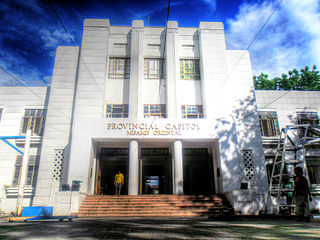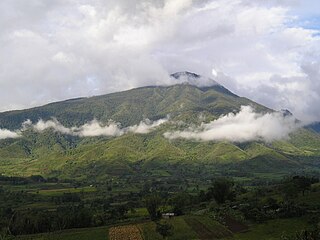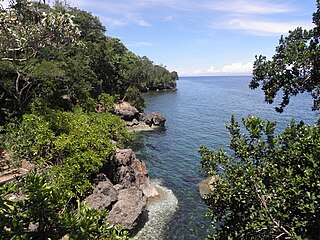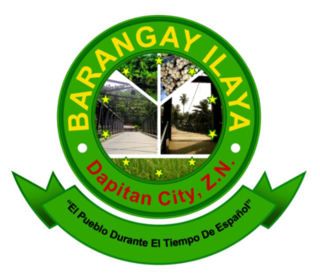
Northern Mindanao is an administrative region in the Philippines, designated as Region X. It comprises five provinces: Bukidnon, Camiguin, Misamis Occidental, Misamis Oriental, and Lanao del Norte, and two cities classified as highly urbanized, all occupying the north-central part of Mindanao island, and the island-province of Camiguin. The regional center is Cagayan de Oro. Lanao del Norte was transferred to Northern Mindanao from Region XII by virtue of Executive Order No. 36 in September 2001.

Misamis Oriental is a province located in the region of Northern Mindanao in the Philippines. Its capital and provincial center is the city of Cagayan de Oro, which is governed independently from the province. There is a move lately to transfer the provincial capital to the municipality of Laguindingan where the airport is now located.

Iligan, officially the City of Iligan or referred to as Iligan City, is a 1st class highly urbanized city in Northern Mindanao, Philippines. According to the 2015 census, it has a population of 342,618 people.

Malaybalay, officially the City of Malaybalay or simply referred to as Malaybalay City, is a 1st class city and capital of the province of Bukidnon, Philippines. According to the 2015 census, it has a population of 174,625 people.

Datu Odin Sinsuat, officially the Municipality of Datu Odin Sinsuat, is a 2nd class municipality in the province of Maguindanao, Philippines. According to the 2015 census, it has a population of 99,210 people.

Linamon, officially the Municipality of Linamon, is a 5th class municipality in the province of Lanao del Norte, Philippines. According to the 2015 census, it has a population of 20,341 people.

Claveria, officially the Municipality of Claveria, is a 1st class municipality in the province of Misamis Oriental, Philippines. According to the 2015 census, it has a population of 48,906 people.

El Salvador, officially the City of El Salvador,, or simply referred to as El Salvador City is a 6th class city in the province of Misamis Oriental, Philippines. According to the 2015 census, it has a population of 50,204 people.

Laguindingan, officially the Municipality of Laguindingan, is a 4th class municipality in the province of Misamis Oriental, Philippines. According to the 2015 census, it has a population of 24,405 people.

Lagonglong, officially the Municipality of Lagonglong, is a 5th class municipality in the province of Misamis Oriental, Philippines. According to the 2015 census, it has a population of 21,659 people.

Libertad, officially the Municipality of Libertad, is a 5th class municipality in the province of Misamis Oriental, Philippines. According to the 2015 census, it has a population of 12,354 people.

Lugait, officially the Municipality of Lugait, is a 2nd class municipality in the province of Misamis Oriental, Philippines. According to the 2015 census, it has a population of 19,758 people.

Naawan, officially the Municipality of Naawan, is a 4th class municipality in the province of Misamis Oriental, Philippines. According to the 2015 census, it has a population of 21,213 people.

Opol, officially the Municipality of Opol, is a 2nd class municipality in the province of Misamis Oriental, Philippines. According to the 2015 census, it has a population of 61,503 people.
The Legislative Districts of Misamis Oriental are the representations of the province of Misamis Oriental in the various national legislatures of the Philippines. The province is currently represented in the lower house of the Congress of the Philippines through its first and second congressional districts.

Metropolitan Cagayan de Oro, also known as Metro Cagayan de Oro, is the fourth largest metropolitan area in the Philippines. It is located on the northern coast of Mindanao, and comprises the two chartered cities of Cagayan de Oro and El Salvador and the eleven municipalities of Alubijid, Claveria, Gitagum, Initao, Jasaan, Laguindingan, Libertad, Manolo Fortich, Opol, Tagoloan, and Villanueva. According to the 2015 Philippine census, Metro Cagayan de Oro has a population of 1,376,363 people.

Cagayan de Oro, officially the City of Cagayan de Oro or simply referred to as CDO, is a 1st class highly urbanized city in Northern Mindanao, Philippines. It is the capital of the province of Misamis Oriental where it is geographically situated but governed administratively independent from it. According to the 2015 census, it has a population of 675,950 people.

Misamis is a former province of the Philippines. It corresponds to the present provinces of Misamis Occidental, Misamis Oriental, Camiguin, Bukidnon, part of Zamboanga del Norte, Lanao del Sur and Lanao del Norte, and part of Cotabato.

The Initao–Libertad Protected Landscape and Seascape is a protected area in western Misamis Oriental, Philippines. At 1,300.78 hectares, the park includes the limestone forests of the old Initao National Park, locally known as Lasang, as well as their adjacent marine waters in the municipalities of Initao and Libertad. Established in 2002, it is home to the Lasang Secret Adventure Park, a theme park which is being promoted by the provincial government as an eco-tourism and corporate events destination. The park is only 27 kilometres (17 mi) southwest of the Laguindingan Airport and 59 kilometres (37 mi) west of the provincial capital Cagayan de Oro.

Ilaya is one of the interior barangays in the Dapitan City, in the province of Zamboanga del Norte. It is located 18.6 km south from Dapitan City proper along Dapitan river. It has a land area of 1,839.75 hectares and a population of 3,123 people as of 2017.

























